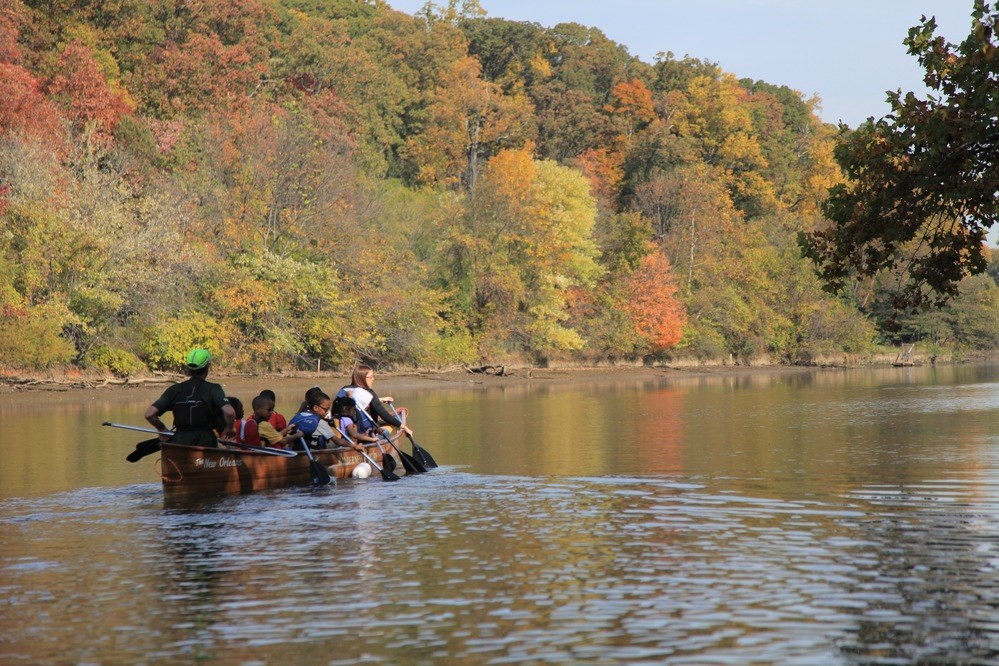Part of a series of articles titled Crystal Clear: A Call to Action.
Article
Crystal Clear: Anacostia Urban Waters Federal Partnership

NPS Photo
The Anacostia River Watershed is home to 43 species of fish, some 200 species of birds, and more than 800,000 people. The river flows through Montgomery and Prince George’s counties in Maryland and the District of Columbia before itsconfluence with the Potomac River. The 176-square-mile watershed is one of the most urbanized in the United States. Impervious surfaces now cover 25 percent of the watershed. However, the Anacostia River and its watershed hold enormous potential to provide abundant natural beauty, wildlife habitat, and a variety of recreational amenities. The Anacostia Urban Waters Partnership works with local stakeholder groups to understand their organizations and share how the federal agencies can support local goals and objectives. Federal agencies have been very active in the Anacostia for a long time, often working closely with the community and local jurisdictions. The partnership facilitates activities with an emphasis on collaboration and coordination, benefiting the local community as well as the federal agencies through the support of ongoing and potential new projects.
Background
The Anacostia River Watershed is one of seven locations selected for the nation’s new Urban Waters Federal Partnership. The goals of this partnership are to reconnect urban areas, particularly those that are overburdened or economically distressed, with their waterways and to improve collaboration among the federal agencies working to improve those waters and the surrounding communities. Specifically, the Urban Waters Federal Partnership will (1) facilitate interagency cooperation to energize existing programs and create meaningful new ones, (2) recognize and build on local efforts and leadership by engaging and serving community partners, (3) work with local officials and effective communitybased organizations to leverage area resources, and (4) learn from early and visible victories to fuel long term action into larger watershed-based restoration strategies. The pilot project and the efforts of all the groups active in the area are focusing on six areas for improvement: (1) reduction of pollution loads, (2) restoration of ecological integrity, (3) improvement of fish passage, (4) increase in wetland acreage, (5) expansion of forest coverage, and (6) increase in public and private participation and stewardship. The ultimate shared goal is to restore the Anacostia River—an American Heritage River within the Chesapeake Bay Watershed—to a healthy state.Status
Many federal and local projects are already underway to improve water quality, restore habitat, enhance local economies, and work with local communities. Reducing Food Deserts With a grant from the U.S. Deparment of Agriculture (USDA), and partnering with the University of the District of Columbia (DC), Groundwork Anacostia DC is working with residents to promote urban gardening and create eco-friendly yards in place of traditional “industrial lawns.” Residents use their property to grow food that supports healthy eating and cooking. The Groundwork Anacostia service area has an obesity rate of 44 percent in Ward 8 (compared with the Ward 3 rate of 10 percent) and lacks grocery stores. Improving Water Quality DC proposed one of the greenest Municipal Stormwater permits in the nation. The EPA is working to finalize the permit this spring to govern the next five years of stormwater controls. Many green features are incorporated as enforceable requirements of the permit. Planting Trees and Educating Youth Since 1990, DC and the USDA Forest Service have partnered to plant and maintain trees in the Anacostia River Watershed. Current efforts with the city and Casey Trees include urban tree canopy assessment, goal setting, and implementation. In addition to thousands of trees planted, partnerships among the District, the National Oceanic and Atmospheric Administration, USDA, Casey Trees, and Living Classrooms support conservation education for school children throughout the District. Restoring Urban Streams DC and the U.S. Fish & Wildlife Service, with support from the Environmental Protection Agency (EPA), Natural Resources Conservation Service, and the National Fish & Wildlife Foundation, are restoring the Watts Branch Stream, one of the most ecologically vulnerable subwatersheds in one of the most economically challenged areas of DC. This project is already improving fish and wildlife resources and water quality in the river. Reducing Trash The EPA recently approved a Total Maximum Daily Load (TMDL) for trash for the Anacostia, making it the first interstate river in the nation with an enforceable trash limit. Each year, hundreds of tons of debris are illegally dumped or washed by stormwater into the Anacostia River. Maryland, DC, and the EPA collaborated with nonprofit groups to develop a TMDL that requires removing 1.2 million pounds of trash from the watershed annually.Participating Partners
Federal Agencies National Park Service, Department of Housing and Urban Development, Environmental Protection Agency, National Institutes for Health, Centers for Disease Control and Prevention, Economic Development Administration, U.S. Department of Agriculture, Department of Defense, National Oceanic and Atmospheric Administration, Department of Transportation, American Council for Drug Education, Corporation for National and Community Service, U.S. Fish and Wildlife Service, U.S. Geological Survey, Department of Energy Non-Federal Entities Anacostia Watershed Society, DC Department of the Environment, Sierra Club, Living Classrooms, Groundwork Anacostia, Smithsonian’s Anacostia Community Museum, Anacostia Restoration Partnership.Last updated: November 6, 2018
